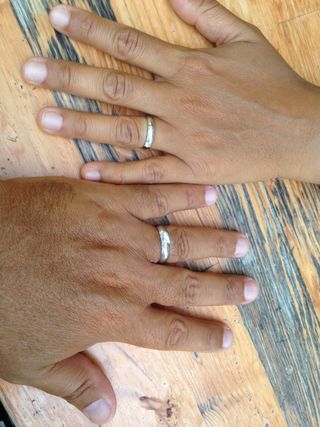Optimism
5 Life Lessons From a Lost Ring
Relationships require teamwork, optimism, and more than a little luck.
Posted August 13, 2014 Reviewed by Ekua Hagan

On a recent Sunday, my family spent part of the day enjoying the glorious weather at my brother-in-law's home on the shores of a beautiful lake followed by a visit to my in-laws’ home bordering a fast-flowing river 10 minutes away. We went boating, kayaked, paddleboarded on the lake, and of course, swam. (These details will soon become relevant.)
Our 90-minute drive back to Montreal was uneventful. Close to home, we stopped at our local Starbucks. As I entered the café, I noticed a man’s thick wedding ring and thought to myself, "His ring is too thick and gaudy,” and proceeded to automatically touch my own wedding ring with my thumb as a means of reminding myself how much I valued it.
But I could not feel my ring. In a split second, I looked at my left hand and noticed that it had disappeared. Once my brain had fully processed this, I went out to the terrace to tell my wife. Since I never take my ring off, and I knew it was on my hand that morning, I knew it had somehow become dislodged during the day’s activities.
This is where the story takes a truly miraculous turn: In a move befitting the top scientists on CSI, my wife downloaded all our photos and videos from the day to see if we could identify a window that might allow us to narrow down when and where the ring might have been lost.
We had some photos from 1:24 p.m. that clearly showed the ring on my hand. We left my brother-in-law's house for my in-laws' at around 4 p.m. During that time, I had engaged in countless activities in a deep lake with rather dark water.
With renewed optimism, my wife moved to the photos and videos taken at my in-laws’. (Recall that they live on the shores of a fast-moving river.) At my in-laws' chalet, I decided to swim against the current there as a form of “water treadmill.” My wife took a video of the “treadmill” swim but then my father-in-law had requested that we take another, from a different angle.
The first video yielded no forensic value but, astonishingly, my wife was able to identify my ring in the second video by slowing it down and freezing the image at the six-second mark. My next and final swim stroke at the eight-second mark showed that I was no longer wearing the ring.
If the story ended there, this would already be a breathtakingly astonishing anecdote in that we had serendipitously identified the two-second window during which the ring was lost.
That evening, my wife and I discussed whether it was conceivable that the ring could still be found. Should I clear my Monday schedule on the infinitesimally small chance that we might retrieve the ring from the bottom of the river? Could we truly be sure that it was indeed lost there and that the current had not swept it miles away? And, assuming that it had simply dropped to the bottom of the river, where the depth varies from roughly two feet at the edge to perhaps five feet where I was swimming, what was the likelihood that we could find a ring on a riverbed littered with innumerable rocks of varying sizes and other debris?
Unfazed by the Herculean challenge, we proceeded with irrationally exuberant optimism. I suggested that we needed to conduct a physics experiment at the river to gauge the movement of a falling ring given the river’s current. We found a worthless ring of roughly equal weight and size and headed back to my in-laws’.
Fortunately, they had the necessary snorkeling gear and water shoes. My wife tied the “experimental” ring to a long string and we began our experiment. The conclusions? One, the ring drops rather quickly to the bottom of the river notwithstanding the strong current, and, two, if it lodges itself tightly at the bottom of the river, the current is unlikely to move it from its hiding place.
At this point, I announced to my wife that I was absolutely certain that the ring was at the bottom of the river and that we simply needed to methodically go over every square inch until we found it.
I wish that I could have taken a photo of the riverbed if only to convey the extent to which this was a difficult, if not nearly impossible, search. I had to come up with a system to mitigate the inherent spatial challenges. Whenever possible, I would only use my hands and feet to anchor myself on larger rocks, as to not alter any of the existing riverbed’s landscape. This was itself a daunting task given the strength of the current. I started to work on my breathing so that I might be maximally relaxed, to allow myself to focus on the task at hand. Finally, I had to find a way to use visual markers on the riverbed to establish which areas I had already covered and which remained to be explored—and commit these to memory.
I quickly realized this would be exponentially more challenging than finding a needle in the proverbial haystack. After all, I was trying to find a ring at the bottom of a fast-moving river! Perhaps 20 minutes into my effort, an ephemeral flash caught my eye. I dove closer to the source to investigate and there, lodged between rocks, was my ring. I grabbed it, saw that it was indeed my ring, and then pulled out of the water and let out a truly visceral primal scream.
This truly miraculous story comes with some important takeaways:
- A successful marriage requires commitment to teamwork. My wife and I worked in tandem to solve a problem that would have likely been impossible for either of us to solve alone.
- The importance of having an analytical and reasoned approach to decision making coupled with an understanding of the scientific method. The “hydraulic” experiment allowed us to prune the search space in a manner that rendered the task more feasible.
- The importance of having a positive and optimistic outlook. It would have been profoundly easier to assume that the cause was lost when I first discovered that the ring was missing. However, both my wife and I held steadfast to the hope that there was a chance that the situation could be redressed. I often joke with her that she has the uncanny ability to take any situation and uncover the proverbial silver lining. This is a wonderful skill to possess as one navigates through the trials and tribulations of life.
- People’s most prized possessions carry deeply symbolic and emotional significance. My attachment to my wedding ring is a powerful symbol of the infinite love that I have for my wife and children. Perhaps I need to slightly rework the classic line from the Marvin Gaye song from “Ain’t no river wide enough, to keep me from getting to you” to “Ain’t no river deep enough, to keep me from getting to the symbol of our love.”
- Take off your wedding ring prior to swimming!
On a related note, some readers might be interested in my earlier Psychology Today post titled How Much Should One Spend on an Engagement Ring?
Follow me on Twitter and Facebook, and check out my recent chat with Joe Rogan.




